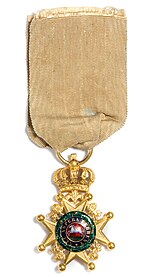| Royal Guelphic Order | |
|---|---|
 Grand cross star, sash and badge of the Royal Guelphic Order (Civil Division) Grand cross star, sash and badge of the Royal Guelphic Order (Civil Division) | |
| Awarded by Kingdom of Hanover | |
| Type | House Order |
| Established | 28 April 1815 |
| Motto | Nec Aspera Terrent (Not afraid of difficulties) |
| Sovereign | Ernst August |
| Grades | After 1841 Grand Cross Commander 1st Class Commander 2nd Class Knight Cross of Merit |
| Former grades | Original Knight Grand Cross Knight Commander Knight |
| Precedence | |
| Next (higher) | Order of Saint George |
| Next (lower) | Order of Ernst August |
Ribbon of the order | |



The Royal Guelphic Order (German: Königlicher Guelphen-Orden), sometimes referred to as the Hanoverian Guelphic Order, is a Hanoverian order of chivalry instituted on 28 April 1815 by the Prince Regent (later King George IV). It takes its name from the House of Guelph, of which the House of Hanover was a branch. Since Hanover and the United Kingdom shared a monarch until 1837, the order was frequently bestowed upon British subjects.
History
Until 1837 the order was frequently awarded to officers in the British Navy and Army, although it was still classed as a foreign order, with British members of the order not entitled to style themselves as "Sir" unless they were also created Knights Bachelor, as many were.
The British link ended in 1837 when Hanover's royal union with Great Britain ended, with Ernest Augustus becoming King of Hanover and Queen Victoria ascending the British throne. When Hanover was annexed by the Kingdom of Prussia in 1866, the order continued as a house order to be awarded by the Royal House of Hanover. Today, its current Sovereign is the Hanoverian head of the house, Ernst August, Prince of Hanover.
Classes
The insignia was based on the white horse on Hanover's arms.
The Order includes two divisions, Civil and Military, the latter indicated by crossed swords on both the badge and star. It originally had three classes, but with several reorganisations since 1841, as house order today it has four classes and an additional Cross of Merit. In descending order of seniority the classes are:
1815–1841
- Knight Grand Cross (GCH). Received a collar chain and badge, a star worn on the left breast, and a badge worn from sash over the right shoulder.
- Knight Commander (KCH). A neck badge worn from a ribbon, with a breast star, smaller than that for the GCH.
- Knight (KH). Wore the badge on the left breast. Versions in both gold and silver were awarded.
Holders of the respective degrees of the order in Britain were entitled to be post-nominally addressed with the initials, which stand for Knight Grand Cross of Hanover, Knight Commander of Hanover and Knight of Hanover. The initial GCG was also used, and was cited in the original statutes of the order.
Gold and silver medals were attached to the order, for award to those not eligible for the order itself, including non commissioned officers and royal servants.
After 1841
- Grand Cross
- Commander 1st Class
- Commander 2nd Class
- Knight
- Cross of Merit
The order
| This section does not cite any sources. Please help improve this section by adding citations to reliable sources. Unsourced material may be challenged and removed. (July 2021) (Learn how and when to remove this message) |
Officers
The Order has six officers: the Chancellor, the Vice-Chancellor, the Registrar, the King of Arms, the Genealogist, and the Secretary.
Officers until 1837
The first six officers were:
- Chancellor: Count Ernst Friedrich Herbert von Münster
- Vice-Chancellor: Georg Nieper
- Secretary: Ludwig Moeller
- King of Arms: Sir George Nayler
- Genealogist: August Neubourg
- Registrar: Sir William Woods
Officers since 1987
- Chancellor: Ernst August, Prince of Hanover
Members
- List of knights grand cross of the Royal Guelphic Order
- List of knights commander of the Royal Guelphic Order
See also
References
- Robertson, Megan C. (2 April 2007). "United Kingdom: The Royal Guelphic Order". Medals of the World.
- ^ Mussell, John, ed. (2014). The Medal Yearbook 2015. Devon, UK: Token Publishing Ltd. p. 56. ISBN 9781908828163.
- ^ Captain H. Taprell Dorling. Ribbons and Medals. pp. 31–32. A.H.Baldwin & Sons, London. 1956.
- "No. 18907". The London Gazette. 24 February 1832. p. 414. Examples of KCH's created Knight Batchelor.
- Disbrowe, Charlotte Anne Albinia (1903). Old Days in Diplomacy : Recollections of a Closed Century, by the Eldest Daughter of the late Sir Edward Cromwell Disbrowe, G.C.G. p 17. London.
{{cite book}}: CS1 maint: location missing publisher (link)
External links
- [REDACTED] Media related to Royal Guelphic Order at Wikimedia Commons
| Kingdom of Prussia |  | |
|---|---|---|
| Kingdom of Bavaria |
| |
| Kingdom of Saxony | ||
| Kingdom of Württemberg | ||
| Kingdom of Hanover | ||
| Grand Duchy of Baden | ||
| Grand Duchy of Hesse | ||
| Landgraviate of Hesse-Kassel |
| |
| Landgraviate of Hesse-Darmstadt | ||
| Grand Duchy of Mecklenburg-Schwerin | ||
| Grand Duchy of Mecklenburg-Strelitz | ||
| Grand Duchy of Oldenburg | ||
| Duchy of Saxe-Weimar | ||
| Duchy of Brunswick | ||
| Duchy of Nassau | ||
| Duchy of Saxe-Altenburg | ||
| Duchy of Saxe-Coburg-Gotha | ||
| Duchy of Saxe-Meiningen | ||
| Duchy of Anhalt | ||
| Principality of Hohenzollern-Sigmaringen | ||
| Principality of Hohenzollern-Hechingen | ||
| Principality of Lippe-Detmold | ||
| Principality of Schaumburg-Lippe | ||
| Principality of Reuss | ||
| Principality of Schwarzburg-Rudolstadt | ||
| Principality of Schwarzburg-Sondershausen | ||
| Principality of Waldeck and Pyrmont | ||
| Free cities | ||
Categories: